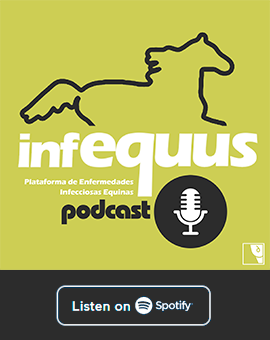Vesicular stomatitis
Etiology
Vesicular stomatitis virus (VSV) belongs to the genus Vesiculovirus in the family Rhabdoiviridae. The most important serotypes are New Jersey and Indiana. There are four viruses that cause vesicular stomatitis: vesicular stomatitis New Jersey virus (VSV-NJ), vesicular stomatitis Indiana virus (VSV-IN), vesicular stomatitis Alagoas virus (VSVAV) and Cocal virus. But VSVAV and Cocal virus are members of the Indiana serotype. It is a low mortality disease in equids and endemic in the Americas.
Epidemiology
Clinical signs mainly afecct swine, cattle and equids. The Vesicular Stomatitis (VS) is an insect-borne disease (arbovirus) and can spread from animal to animal by direct contact (contaminated saliva and vesicle material). VS is seasonal, in USA occurs in the spring and in the begining of the summer, and in tropical regions in the rainy season.
Establishing movement controls and a prompt diagnosis in swine and catle to detect diseases such as Food and Mouth Disease (FMD) is very important, as well as the implementation of vector control measures.
Pathogeny
The pathogenesis is typical of viral infections, with a series of events terminating in the release of progeny virions and cell death. Infection of epithelium with VSV induces intercelular edema in the Malpighian layer, and the epitelial cells become separated. Vesicles develop within 48 hours of experimental inoculation, when the necrotic and edematous mucosa breaks free from underlying tissue, forming a cavity filled with exudates.
Clinical signs
An initial febrile period is followed by formation of vesicles and lessions, in the oral mucosae, horse´s muzzle, feet (coronitis) and udders, causing limp and ptyalism, even anorexia. Unless secondary infections occur, horses recover completely within 2-3 weeks.
Diagnosis
Laboratory tests are essential in order to do the diagnosis because VS is clinically indistinguishable from several other vesicular diseases. However, very few infectious agents in equids have those clinical signs, and the vesicle formation in horses are highly associated with Vesicular stomatitis.
Treatment
Treatment is supportive. Frequent rinsing of lesions with mild antiseptic solutions as a supportive care measure, and the application of topical antibiotics may help prevent secondary bacterial infections. A soft diet in animals with oral lessions is indicated.
Prevention and control
Commercial vaccines are only available in some endemic regions of Central and South America, not in the U.S. During outbreaks, infected animals should be kept away from any other animals to prevent direct contact. Quarantines and animal movement restrictions can help to reduce virus spread. Good sanitation and disinfection of vehicles and fomites is recommended. Finally the control of insects and protection of animals in shelters is recommended.
Public Health Considerations
VS in humans occurs as an acute, self limiting infection similar to influenza. Fever, general malaise and mialgia are the clinic signs. Vesicular lesions are rare. Most people recover within 4 and 7 days. Human infection occurs by handling infected animals, and by contact with contaminated fomites, tissues and blood cultures. To prevent infection Personal Protective Equipment must be worn.
Vesicular Stomatitis is considered a reportable disease by the OIE.
References
- ‘Equine Infectious Diseases’, Debra C. Sellon, DVM, PhD, DACVIM and Maureen T. Long, DVM, PhD, DACVIM. SAUNDERS ELSEVIER.
- The Center for Food Security and Public Health
- MAPAMA

